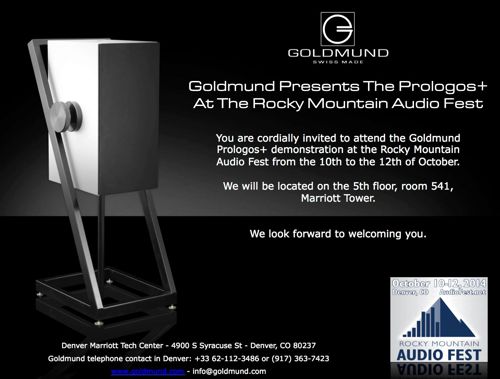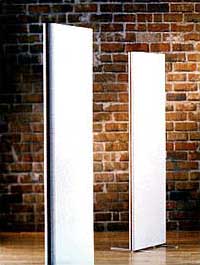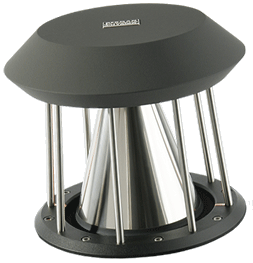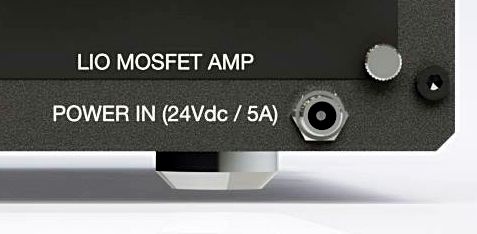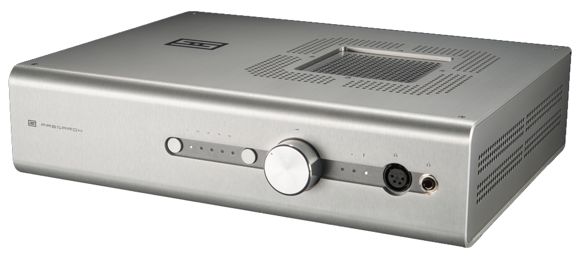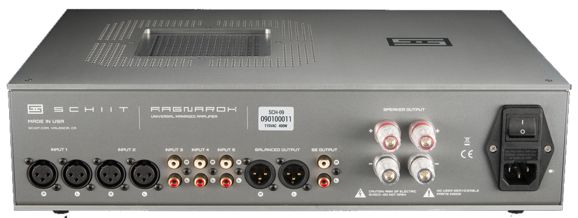| John Broskie's Guide to Tube Circuit Analysis & Design |
| 15 October 2014
RMAF 2014 Unfortunately, sci-fi and fantasy no longer compel me as much as they had when I was sixteen. Why was I so tempted to depart from reality? Reality often disappoints. I am sure that I am not alone in finding the usual audio-show routine—you know the one, where the audio reporter for a glossy audio magazine effusively describes new products which are only new in the sense that they are new only to some company's product line, but are otherwise identical to what a hundred, if not a thousand other companies already offer, say a new three-way loudspeaker or a new class-D power amplifier or new fat cables—too tedious for any thinking, sensitive soul to endure. I cannot blame the reporter; it is his job, after all, to fake an enthusiasm that only a pimpled sixteen-year-old could sincerely muster. Do not get me wrong here, as I do not want to paint too glum a picture, for this year's RMAF was an enjoyable excursion—albeit for many of the wrong reasons. Imagine that you arrive at a tourist destination, say a museum or zoo, and you surprisingly find it sparsely peopled. The long lines are gone and with them the long waits. Perhaps, there is an all-important, live TV special, say Miley Cyrus and Katy Perry tying the knot; but you do not care, as their loss is your gain. Well, out of the sixteen or so audiophiles whom I hoped to see this year, only about eight showed up. I doubt that my ratio exactly matches the RMAF's ratio for number attendees this year compared to years past, but I do know that it was so much easier riding the elevators this year compared to the first RMAF I attended; no long waits, no waiting for the second elevator, and no need to deeply inhale before squeezing in the elevator. In addition, I went into many rooms where only a sales rep stood, waiting for some visitors. As a result, I had many great conversations; but then, I have also had great conversations at funerals and wakes.
On the other hand, the headphone portion of the show, the Can Jam 2014, was alive and kicking. Filled with eager, intense young men, the Can Jam provided the only real evidence that I needn't have brought a wreath and pay my last respects to Audio. When I mentioned this, I was repeatedly told that it was only due to the inexpensive headphones and headphone gear that attracted the young. No doubt there is some truth in that observation, but I doubt that it goes far enough, besides there was plenty of ridiculously expensive headphones and headphone amplifiers to be had. No, I am sure that the missing explanation is more along the lines of headphone listening being fundamentally different from loudspeaker listening. Because the sonic presentation offered by headphones differs so greatly from what loudspeakers deliver, we end up listening to different aspects of a recording. I know that this is true with me. With headphones clamped about my head, I cannot escape the lyrics and the semantic content buried within the words; with loudspeaker playback, in contrast, the words and their meanings are easy to hide from, as they meld with the instruments into the musical background, something akin to sonic wallpaper. On the other hand, with loudspeakers I can hear—and indeed feel through the seat of my pants—the scale and heft of the music, something which no headphone can reproduce. Thus, I have discovered that some of my CDs better suit headphone playback, while others require playback on big loudspeakers. (What about LPs, to be honest, I definitely prefer loudspeaker playback over headphone listening for LPs for the simple reason that the ticks and pops are, much like the lyrics, more easily ignored with loudspeakers.)
Because headphone listening compels our attention, forcing us to attend to the meaning of the words sung, it is natural for the young to clamor for higher-quality headphone listening. How so? Imagine that you are young, weak on experience, strong on emotion and desire; therefore, you need to hear and heed a song's words, as the lyrics—with their unrestrained and excessive emotional expression—constitute something like a cheat-sheet to life. Like the experiences of the young, these lyrics are unremittingly affective, emotive, impassioned, moving, passionate, and overly sentimental, but then so, too, are the young. Thus, the lyrics are, for the inexperienced, the innocent—the young in other words—altogether compelling and important. And certainly more important to the young than they are to the old, the world-wearied, those with well-worn hearts, hearts that were once broken, but are now defended by thick, tough scars. As William Gass put it,
I believe that it was T. S. Eliot who pointed out that art can fill the gaps in our emotional growth; and when we no longer retain these voids, the poetry, art, and music that once seemed profound, essential, and electrifying, when young and mostly empty, now only irritates us upon our re-experiencing them, serving only as a reminder of our past fatuous follies and abounding absurdities. So, to paraphrase that great grump of a German Philosopher, Arthur Schopenhauer, We envy the young man and his $1,000 headphones, but we only half envy the old man and his $100,000 loudspeakers.
For more of my observations on the differences between loudspeaker and headphone listening see Blog Number 61.
Personalities I was remind of the time I spoke to the late David Manley about tube circuitry, in that Frank doesn't hold anything back, no super-secret trade secrets for him. This is rare with circuit designers (and a many audiophiles), who believe that their power or mojo corresponds to the amount of secrets they, and they alone, know. (That same day, I was talking to secretive audiophile who had never heard of me. He wanted to me to know that he knew all sorts audio circuit secrets, but that he wasn't about to reveal them. Soon enough, he realized that he had gotten the direction wrong, that he had far more to learn from me than I from him. Suddenly, he no longer cared about his paltry secrets, as he wanted mine. Thing is, I don't keep audio secrets; I spill the beans. All he had to do is do what you are doing right now.) Well, Frank knows too much to hoard his secrets, which is why he published his Audio Basics Newsletter, all of which are free and downloadable at the AVA web site.
RMAF Trends I was given a demonstration of a product that purported to fix the problem of room interactions with the loudspeakers. When the DSP was switched in, I was supposed to emit oohs and aahs; when switched out, moans and groans. Well, it didn't turn out that way. Both settings had their pluses and minuses. In other words, it was by no means a slam dunk. I think the big mistake they made was in using high-quality loudspeakers, a big mistake. I heard a similar demonstration a few years ago that wisely used undeniably bad-sounding loudspeakers. When the DSP was switched in that time, the result was magical. Not this time. I heard the similar thing happen long ago at John Atwood's place, when he had borrowed an analog-signal-processing box that made cheap kitchen loudspeaker sing, but made his first-rate Celestion loudspeakers cough and stutter. I am fighting the urge to resort to sexist analogies here. You know the kind that mentions woman and makeup. So, how about this one instead: the secret sauce at the local fast-food joint makes cheap hamburger taste yummy, but ruins expensive filet mignon. Another trend is no wires. I am all for it, as I hate the tangle of snaking cords. You can buy loudspeakers that receive either WiFi or Bluetooth radio signals that are then passed on to on board DACs and DSP and electronic crossovers and internal power amplifiers. By the way, I remember attending an audio show about 30 years ago, where I had a great conversation with a loudspeaker designer. He had been an EE and his specialty was audio power amplifiers—until he discovered the joys of speaker design. He told me that it was insane of him to have wasted his time on amplifiers, as halving their distortion made almost no difference to the ear, which made sense as even the best loudspeaker routinely produced 10%, 20%, 30% of distortion; that bad loudspeakers, i.e. all loudspeakers, were the huge audio elephant in the listing room, not power amplifiers. But then I have also spoken to power amplifier designers who damn the designers of line-stage amplifiers and phono preamps, as they only have to muster a mere 1V of output signal and drive trivial 10k loads, whereas their amplifiers had to deliver big volts and heavy current into a crazy reactive loads. And all of the above have bemoaned the snake-oil industry of high-end audio interconnects and loudspeaker cables. But I have also heard the makers of expensive wire decry the scandal of selling magic rocks, equipment stands, isolation mats, and all other sorts of audio accessories. Another continuing trend is the revival of vinyl. Room after room offered spinning LPs. Indeed, the best sound did come from these rooms. I am not saying that all LPs sound great, only that the best sounds came from LPs. At the same time, the computer-based stereo system is here to stay—well, for at least the next few years. One trend that I don't like is the ever increasing prices. For example, I sat down in one room and found myself quite liking the pair of large three-way loudspeakers that were playing. I thought to myself that they were pretty darn good, almost worth the $7,000 to $10,000 price tag I expected. Well, I was off by about $50,000. Seriously? Is it really possible to pay more for a pair of loudspeakers that hold two cone drivers and a dome tweeter than what a 2015 BMW 5 Series car costs. Sadly, in the world of high-end audio it is.
Here is another example, after I had listened to the Goldmund ProLogos Wireless loudspeakers, I staggered out of the room, having heard the $40k price tag.
I then ran into a buddy who asked me what I thought of the loudspeakers. I told him that while Goldmund may employ the best engineers in Switzerland, they must be using a temp service to staff their accounting department, as they must have placed the decimal point in the wrong place, as I cannot imagine paying more than $4k for the loudspeakers. He was taken aback by my quip and he pointed out that the speakers held metal enclosures and built-in metal frames. I countered that so did a fine $40k car. He then told me that the speakers contained a radio receiver and power amplifiers. Once again, I countered that so did a fine $40k car. He just shook his head in disbelief that anyone could be so dense not to see the value in a $40 pair of loudspeakers, but persisted with the last observation that they came with a USB dongle to stream the digital data from your preamp to the speakers. Upon hearing this, I capitulated and said, "Wow! A USB dongle, well hell yes they are worth every penny of the $40k."
At the other extreme, Magnepan's Model 1.7 flat-panel speaker cost a reasonable $2,000 the pair and they sound fabulous. Yes, they are big and flat and require a powerful amplifier, but they do sing. The smaller and less expensive, the KEF LS50 , stole my heart and ears at the 2012 RMAF, continued to wow me. Thus, I was pleasantly surprised to see that my friend Don Walker of Fort Collins Audio now sells the small KEF loudspeakers. Indeed, I thought maybe my rave review of them had steered Don's ears in their direction, but no, as he had discovered them on his own. If the speakers being small is essential and if you can afford it (about $7,000), the Joseph Audio Pulsar loudspeaker are fantastic. And Martin Logan Ethos electrostatic-hybrid speakers are good values at less than $7,000 the pair.
The second I walked into the German Physiks room, I was at ease, as their Unlimited MKII loudspeaker filled the room with the same natural sound that I had heard the year before. In short, they are certainly doing something right, which means that just about everyone else is doing something wrong. Where most speakers spit sound at you, the German Physiks loudspeakers pour music into the room. They are the loudspeakers that I could happily listen to forever. I only wish that they cost half as much. Indeed, I wish that they came out with a near-field version of the speaker, say with a 5-inch driver in a fairly tall, but narrow enclosure that could be placed near to your listening chair. Why? I am inclined to believe that such a speaker system would be the missing link between super-high-resolution headphones and big loudspeakers. With the smaller loudspeaker within touching distance, the 5-inch single driver could still play loudly. More importantly, the omni-directional dispersion of sound would create a natural-sounding ambience: the wedding of headphone detail with big speaker weight and impact, but without the claustrophobia of headphones or the huge footprint and expense of massive speakers.
Most Innovative Product
Still don't see it? It's right there, at the bottom right corner. Here is a close up.
There is no AC connecter; instead the unit attaches to a 24Vdc external power supply. What is surprising about that, as many audio products do the same? Well, the surprising, innovative thing is what then happens inside the chassis. Within the enclosure, great gobs of capacitance, farads, not microfarads, resides. Vinnie has moved beyond batteries, which were never real energy storage devices, being electro-chemical voltage generators. Capacitors actually store voltage. And unlike batteries, they can charge up rapidly and do not age as quickly. For example, most lithium batteries are only good for about a 1,000 recharge-discharge cycles; but a high-quality film can sustain a near infinite number of recharge-discharge cycles. Of course, you cannot get 10,000 farads, yes farads, in film capacitors, so Vinnie uses the new supercapacitors, which are low-voltage, super-high capacitance capacitors and altogether amazing. Unfortunately, while supercapacitors power density is between 10 to 100 times greater than batteries, their energy densities are only about 10% that of batteries. The result is that they must be charged up much more often than a rechargeable battery would. Well, Vinnie's brilliant move is to use multiple banks of super capacitors which then trade off as one becomes depleted. In other words, his LIO is effectively off the power grid and doesn't use batteries. Is being off the grid important? Oh yes, indeed. If you use a good isolation transformer and a scope (or just a battery powered scope in a plastic case and you are super careful) you can look at the sine wave emerging from the wall socket. Well, it ain't pretty. Where a perfect sine wave should appear, we most often encounter an ugly, deformed waveform, which reminds us of plastic surgery gone bad and the late Michael Jackson's nose. Then there is the issue of RFI and poor house grounding and a bit of DC riding on the AC—all of which conspire to ruin your listening experience. As a result there is a recording studio in Canada that runs all of its audio equipment off of boat batteries. I used to know this fellow who used a Die-Hard battery to power the heaters in is tube gear. The huge problem with batteries is that they weigh a ton and age and die; In addition, they can release toxic fumes and their harmless disposal requires some thought. The following is a story that I have told hundreds of times before, but I might not have included it here. Back when I was in college in the late 1970s, a group of audiophiles I knew wanted to augment the power-supply capacitors in our solid-state power amplifiers, so we made a group buy of 26 huge computer grade caps that were much bigger than a Fosters beer cans. The heavy and big box arrived at my apartment and I decided to try an experiment: I hooked up all 26 caps and attached them to my solid-state power amplifier. I knew, however, that if I flicked on the power switch, the rectifiers and power switch would melt, if not vaporize, so I unplugged the amplifier from the wall before flipping on the power switch. I then twisted in place two 10k/10W resistors in series with the power-cord terminals and I slowly pushed the resistor leads into the wall socket, while watching the voltmeter reading of the power-supply voltages slowly climb. As the resistors began to heat up and smell, I pulled them free from the wall socket; and then pushed them back in, once they had cooled off. Eventually, the power supply was completely energized, all 2.6 farads of capacitance at +/-50V. I then shook free the resistors and plugged the amp into the wall directly and sat down to listen. A major disappointment, as I expected sonic glory. Instead, the bass did improve a tad, but the amplifier didn't sound radically better. Crestfallen, and while the music played on, I pulled the plug from the wall socket. The music suddenly sounded much better, sounding much more refined and relaxed and quite a bit more tube like. I pushed the plug back in and the sound instantly coarsened. For the first time, I could hear a sonic texture that I had never been aware of, a sort of granular, buzzing overlay. Much as you only notice that a neighbor on your block has been running a power saw when he turns it off, and you suddenly realize that it had been quietly annoying you all along, but that you failed to consciously notice it. Well, since that day, I have wanted to build a tube-based phono stage that ran on capacitors. Since LPs only play for up to 30 minutes a side, many being much shorter in time, say 18 minutes, I only would need a time window of 30 minutes long. And as I flip the LP over, I would charge the capacitors up, as, unlike batteries, caps can be charged up quickly. Of course the capacitors would have to be huge in value and the preamp light in current draw; think two 12AX7 tubes. And something like an emitter or source follower would be needed to keep the B+ voltage fairly constant. In other words, although the B+ might only be 200V, the caps would have to be charged up to 500V (or more). Sadly, the math is bad. With even the light plate current draw of a 12AX7, the capacitor would have to be as big as a large suitcase or, possibly, a refrigerator. For example, a 0.03F capacitor, in other words a 30kµF capacitor, charged up to 600V, drained by a 6mA current load, would last 1,800 seconds or 30 minutes before the charge fell to 240Vdc, whereupon it would be recharged, while you turn the LP over. Unfortunately, they don't make high-voltage supercapacitors. Well, that is actually not altogether true, as photoflash capacitors come close. Photoflash capacitors were designed for use with a camera’s flash unit, as they store a relatively large high-voltage charge and they can deliver that charge quickly, which handsomely suits the needs of a flash bulb. What about audio; how well do these capacitors work with tube equipment? Fairly well is the quick answer, if a few key provisions are followed. The photoflash capacitor’s large volumetric efficiency betrays that these capacitors cannot tolerate a steady and heavy use. Using them near their rated voltage or rated temperature is sure to shorten their life. So too using them in a power supply, as the main filter capacitor, exposed to the heavy hammering of spiking charging currents, is sure to kill them. I remember seeing big, red, American-made, snap-in photoflash capacitors that offered something like 1,000µ at 350V. If they are still made, which I doubt, you would need 30 of them to make a go of the capacitor-powered phono stage. In short, Vinnie Rossi has a better solution. And although only propeller-heads like me will appreciate how clever his design is, I am sure that everyone's ears will appreciate his innovation. By the way, there is a lot more to like about Vinnie's new product, such as its completely modular design. In other words, if you don't need a phono stage, you don't have to pay for one. If you change your mind later, Vinnie can add the phono stage or a new DAC section; it is modular: it is designed to accept modules, which allows easy alterations or upgrades and repairs.
Schiit Audio
The Ragnarok is ostensibly a headphone amplifier, albeit a very good headphone amplifier, one that can drive the new planer headphones to high SPLs, either in balanced or conventional unbalanced mode. But it is much more than just that. It is also a line-stage amplifier that accepts two balanced and three unbalanced inputs, which uses relays and ladder attenuators to decrease the volume, which also sports an output stage so robust that it can deliver 100W into 4-ohm loudspeakers, which uses a MOSFET-based Circlotron output stage.
That is a lot of functionality for a $1,699 price tag. Ponder this: the Ragnarok and a pair of Magnepan 1.7 loudspeakers and a set of quality $1k headphones and Schiit's own most expensive DAC, the Gungnir, and a decent turntable and cartridge and Schiit's Mani phono preamp and some fancy wires will still not add up to $10k, which is what some audiophiles pay just for their speaker cables. In fact, my quick calculation brings the total to just $7k. This is truly the twilight of the high-end, high-cost audio gods. Let me put it this way, if I didn't always build my own line-stage and headphone and power amplifiers, I would definitely buy a Ragnarok.
Next Time
For those of you who still have old computers running Windows XP (32-bit) or any other Windows 32-bit OS, I have setup the download availability of my old old standards: Tube CAD, SE Amp CAD, and Audio Gadgets. The downloads are at the GlassWare-Yahoo store and the price is only $9.95 for each program. http://glass-ware.stores.yahoo.net/adsoffromgla.html So many have asked that I had to do it. WARNING: THESE THREE PROGRAMS WILL NOT RUN UNDER VISTA 64-Bit or WINDOWS 7 & 8 or any other 64-bit OS. I do plan on remaking all of these programs into 64-bit versions, but it will be a huge ordeal, as programming requires vast chunks of noise-free time, something very rare with children running about. Ideally, I would love to come out with versions that run on iPads and Android-OS tablets.
//JRB |
I know that some readers wish to avoid Patreon, so here is a PayPal button instead. Thanks. John Broskie
Kit User Guide PDFs
E-mail from GlassWare Customers
High-quality, double-sided, extra thick, 2-oz traces, plated-through holes, dual sets of resistor pads and pads for two coupling capacitors. Stereo and mono, octal and 9-pin printed circuit boards available.  Aikido PCBs for as little as $24 http://glass-ware.stores.yahoo.net/
Support the Tube CAD Journal & get an extremely powerful push-pull tube-amplifier simulator for TCJ Push-Pull Calculator
TCJ PPC Version 2 Improvements Rebuilt simulation engine *User definable
Download or CD ROM For more information, please visit our Web site : To purchase, please visit our Yahoo Store: |
|||
| www.tubecad.com Copyright © 1999-2014 GlassWare All Rights Reserved |





